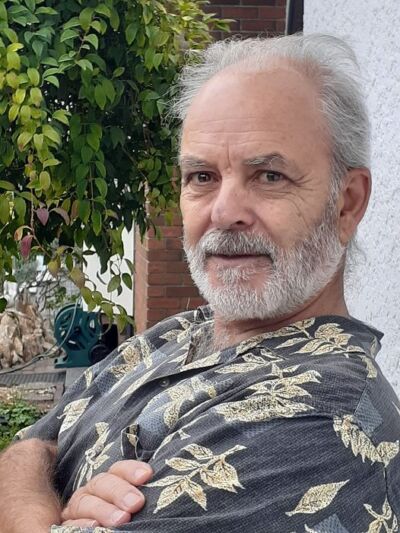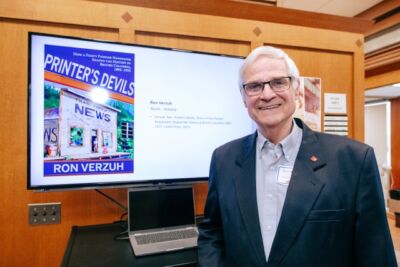Roughing it in Port Hardy
Past the End of the Road: A North Island Boyhood
by Michel Drouin
Madeira Park: Harbour Publishing, 2024
$24.95 / 9781990776670
Reviewed by Ron Verzuh
*

Memories of childhood are engaging when they involve events or personalities that catch our attention. In Michel Drouin’s memoir, we get a strange mix of both as he leads us on a coming-of-age adventure at the far north end of Vancouver Island.
Drouin’s parents hailed from Quebec and arrived as settlers at Port Hardy in 1953, the year of his birth. Described as a “one-horse town,” we witness its growth from “sleepy logging village” to a thriving three-industry boom town of 5,000 and of Drouin’s connection to two of those enterprises, fishing and logging.
Through Drouin’s boyhood eyes, we get a surplus of details about the coastal town as a rough-hewn waterfront location of makeshift buildings, a commercial fishing dock, fishing vessels, and passing logging trucks.
Anyone who has travelled through Vancouver Island logging country will remember the roar of the big trucks as they arrive at “elephant crossings.” The name comes from the image of trucks carrying their trailers trunk-like on top of the cab. For Drouin, this became part of his surroundings as he often joined his dad on logging boom expeditions.
We also learn of the intricate workings of all of the machines involved in operating a small fishing vessel. For example, we are offered a detailed description of his father Jules’s boat, the Seagull, an old salmon trawler, and we go on several fishing trips as the young boy learns the fishing trade.
Some might say we learn too much, but for former Port Hardy residents it will offer many memories of life on the coastal edge. In fact, Drouin provides an exhausting list of every inlet, harbour, river, cliff, mountain trail, abandoned cabin, and abandoned shed.

Along the way, we also meet some of the more colourful characters that wash up at Port Hardy. A young Patrick Moore of Greenpeace fame makes an appearance representing the Pacific Salmon Society opposing a new local mine. The lesser known Shorty (Reginald) Sagar was among the several local alcoholics that enjoyed the home-brewed “Kickapoo Joy Juice.” Einar Johnson, another member of Drouin’s cast, was a “crusty old handlogger/fisherman who seemed to like kids around.”
There are plenty of hippies populating the story as they move farther back to the land and out of the reach of authorities searching for US draft resisters. Drouin has a strikingly good memory of his youthful exploits. As a childhood amnesia sufferer, I am envious. Every nook and cranny of the 1950s outback gets mentioned by name and specific location though Drouin was still a pre-teen at the time. In fact, most of the book is a record of his years up to the late 1960s when he was still not an adult.
We follow him through an embarrassing moment at grade school when he is forced to learn ballroom dancing. We catch him in acts of thievery for which he pays a price. He takes us on his ‘midden’ visits. These can be mounds of old waste dumps or native burial sites that can contain historic artifacts from earlier human occupation. We also climb sheer cliffs on the water’s edge as he gropes for finger and toe holds. It is a kid’s world of discovery that Drouin shares with us in abundance.
We are also passengers on fishing and deer hunting trips and I confess that I found them difficult reading. I am neither a hunter nor a fisher. Frankly, I would be hard-pressed to survive Drouin’s youth. I was a small-town kid and some of my friends went hunting and fishing with their dads. I did not. My mother was a life-long animal rights activist and I was imbued with more of her views than his.
For those who still hunt and fish, this is a book that will appeal with its detail of a life I have never experienced. Moby Dick, with its long sections on the practicalities of whaling, might have been one of Drouin’s writing inspirations, for at times the book reads like an instruction manual.
Drouin describes in up-close detail the skinning of a deer or a bear or the cleaning of a halibut or salmon, but the how-to guide was lost on me. I can see the appeal for others wishing to relive that killer shot with a powerful rifle or the pull of the line bringing home a fighting coho salmon.
So, Drouin’s story is not for the squeamish nor for anyone who naively sees nature as a glorious playground to be preserved and protected. Drouin grew up acquiring the values and the skills of a woodsperson. He is someone who can hike to the far northern point of Vancouver Island, find safe places along the way, and survive to tell about the the beauty of the rugged far west coast.
He learned to take what he needed from nature. A deer stalks into his back yard and his first instinct is to grab his rifle and shoot it. Same with a bear searching for food in the neighbourhood. His young spouse had expressed a liking for bear meat. Some of the details are gruesome for the likes of me.
Let me step out of my holier-than-thou pose to say that I eat meat and like it. That gives me hypocrite status, I realize, but as a reader I was unhappy to have my hypocrisy exposed so vividly. Hunting and fishing for survival is part of life for an increasing number of North Americans. The Port Hardy memoir reminded me that I am not of that ilk and would likely die quickly if marooned on a deserted coastal island in Drouin’s backyard.
Drouin may fit the mould created by BC’s most famous conservationist Roderick Haig-Brown, but I’m not so sure. Haig-Brown spent a lifetime fighting for more respect for nature. This book is a personal account of a boy growing up in an environment that forced him to outfit himself to live on and off the grid.
Photographs of the author and his family are helpful in situating the story, but there are too few of them and they are of poor quality. Famous BC artist E.J. Hughes is mentioned at least twice, but we never get to see any of his colourful paintings of the gorgeous landscape Drouin describes. A half-page map was inadequate for a book that refers so often to local placenames.
Past the End of the Road is a remarkable feat of childhood memory. It is a story about growing up that will especially appeal to readers interested in roughing it, acquiring survival skills or testing their endurance on the edge of B.C.’s still somewhat untrampled wilderness. If I ever found myself in a similar situation, I’d want Drouin right beside me but it probably would be an uncomfortable match. I’m as likely to dress a dead deer as fly to outer space.
*

Ron Verzuh is a writer, historian, and documentary filmmaker.[Editor’s note: Ron has recently written two essays for BCR regarding British Columbia links to the film industry: Hello Oscar, Eh! and When Hollywood Calls. He has recently reviewed books by Hetxw’ms Gyetxw (Brett D. Huson), Haley Healey, Keith G. Powell, Geoff Mynett, John Farrow, and Andrea Warner for The British Columbia Review; he also contributed an essay about trade unionist Harvey Murphy.]
*
The British Columbia Review
Interim Editors, 2023-24: Trevor Marc Hughes (non-fiction), Brett Josef Grubisic (fiction)
Publisher: Richard Mackie
Formerly The Ormsby Review, The British Columbia Review is an on-line book review and journal service for BC writers and readers. The Advisory Board now consists of Jean Barman, Wade Davis, Robin Fisher, Barry Gough, Hugh Johnston, Kathy Mezei, Patricia Roy, Maria Tippett, and Graeme Wynn. Provincial Government Patron (since September 2018): Creative BC. Honorary Patron: Yosef Wosk. Scholarly Patron: SFU Graduate Liberal Studies. The British Columbia Review was founded in 2016 by Richard Mackie and Alan Twigg.
“Only connect.” – E.M. Forster
6 comments on “Roughing it in Port Hardy”
It’s a pity this reviewer’s preconceptions prevented him from appreciating the value of Michel Drouin’s tales of a mid-20th century working class boyhood in a remote B.C. coastal town. Past the End of the Road offers readers a vibrant picture of a now vanished way of life, one which, perhaps because of its working class perspective, has been far too seldom described by those who actually lived it. As for what the reviewer calls its “surplus detail”, it is precisely this wealth of detail that makes the book so interesting and valuable as an account of how working people adapted to living in coastal company towns. Readers who are capable of setting aside their preconceptions about us will find the book both immensely enjoyable and instructive.
I’ve never known a historian to complain about “up close detail.” I don’t think we get enough of it in our current surface culture. I grew up in the west coast salmon fishery, and before working in the canneries I learned to dress a salmon from something I read in a Roderick Haig-Brown book. Looking forward to this book!